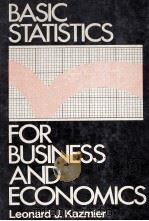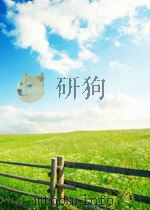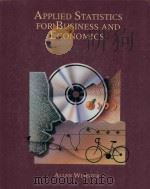《STATISTICS%FOR BUSINESS AND ECONOMICS》
| 作者 | 编者 |
|---|---|
| 出版 | SOUTH-WESTERN COLLEGE PUBLISHING |
| 参考页数 | 945 |
| 出版时间 | 1995(求助前请核对) 目录预览 |
| ISBN号 | 0538840331 — 求助条款 |
| PDF编号 | 812860528(仅供预览,未存储实际文件) |
| 求助格式 | 扫描PDF(若分多册发行,每次仅能受理1册) |
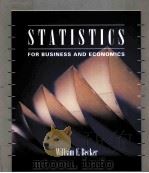
1 COLLECTION AND PRESENTATION OF DATA1
1.1 Introduction2
1.2 Population and Sample Data3
1.3 Sampling and Statistical Analysis5
1.4 Data Sources9
1.5 Experiments and Randomization13
1.6 Other Types of Samples14
1.7 Organizing,Condensing and Presenting Quantitative Data17
Frequency Distributions17
Histograms21
Cumulative Frequency Distributions21
1.8 Stem-and-Leaf Graphics (Optional)26
1.9 Presenting Qualitative Data31
2 DESCRIPTION AND SUMMARY OF DATA43
2.1 Introduction44
2.2 Descriptive Summary Measures45
2.3 The Mean as a Measure of Central Tendency46
2.4 The Weighted Mean49
Approximation Method49
Comments on Approximating a Mean51
Exact Method52
2.5 Applications of the Mean to Quality Control53
2.6 The Median as a Measure of Central Tendency57
Locating the Median in the Original Data Set57
Locating the Median in Grouped Data60
Algebraic Approximation of the Median60
Graphical Approximation of the Median61
2.7 The Mode as a Measure of Central Tendency64
2.8 Percentiles,Deciles,and Quartiles66
2.9 Skewness68
2.10 Measures of Dispersion68
2.11 The Range72
2.12 The Interquartile Range and the Box Plot75
2.13 Variance and Standard Deviations77
2.14 The Variance and Standard Deviation in Frequency Form82
2.15 Data Location and the Standard Deviation86
2.16 Looking Ahead89
3 PROBABILITY105
3.1 Introduction106
3.2 Relative Frequency and Probability107
3.3 Experiments,Outcomes,and Probability107
3.4 Events and Probability110
3.5 Determining the Sample Space111
3.6 Counting Techniques113
3.7 Multiple Events118
Unions and Intersections119
Complements119
Conditional Probability121
3.8 Independence123
3.9 Subjective Versus Objective Probability133
3.10 Concluding Comments137
4 RANDOM VARIABLES143
4.1 Introduction144
4.2 Random Variables and Probability145
4.3 Probability Mass147
4.4 The Expected Value of a Random Variable148
4.5 The Dispersion of a Random Variable152
4.6 Risk Assessment154
Standard Deviation Comparison154
Coefficient of Variation Comparison155
4.7 Multiple Random Variables158
4.8 Joint Probability Distributions158
4.9 Additive Probability163
4.10 Linear Functions of Random Variables165
4.11 Expected Value and Variance of Sums of Random Variables166
4.12 Covariance and Dependent Random Variables (Optional)169
4.13 Concluding Comments172
5 DISTRIBUTIONS OF DISCRETE RANDOM VARIABLES179
5.1 Introduction180
5.2 The Binomial Distribution181
5.3 The Binomial Probability Mass Function183
Determined with a Computer185
Determined with a Binomial Table186
5.4 Location and Dispersion193
5.5 The Hypergeometric Distribution200
5.6 The Poisson Distribution204
5.7 Concluding Comments211
6 DISTRIBUTIONS OF CONTINUOUS RANDOM VARIABLES217
6.1 Introduction218
6.2 Continuous Random Variables and Probability Distributions219
6.3 Normal Distributions226
6.4 The Standard Normal Distribution228
6.5 Calculations with the Standard Normal Table233
6.6 The Lognormal Distribution (Optional)240
6.7 Concluding Comments245
7 SAMPLING AND SAMPLING DISTRIBUTIONS251
7.1 Introduction252
7.2 Probability Samples253
7.3 Simple Random Samples253
Blind Draw254
Random Number Table255
Computerized Random Number Generator256
7.4 Systematic Sampling257
7.5 Stratified Sampling259
7.6 Cluster Sampling260
7.7 Sampling Distribution of the Sum of Random Variables261
7.8 Sampling Distribution of the Sample Mean265
7.9 Sampling Distribution of the Sample Mean for Large Samples274
7.10 Sampling Distribution of the Sample Mean for Small Samples278
7.11 Sampling Distribution of the Sample Proportion281
7.12 Concluding Comments284
Appendix 7 Avoiding Errors in Sampling289
Validity289
Reliability290
Measurement291
Omitted and Missing Observations291
8 ESTIMATION295
8.1 Introduction296
8.2 Point Estimation297
8.3 Properties of Estimators298
8.4 Confidence Intervals301
8.5 Confidence Interval for the Population Mean302
8.6 Level of Confidence305
8.7 When σ Is Unknown307
8.8 Confidence Interval for the Mean,σ Unknown (and n small)310
8.9 Estimating the Population Proportion π315
8.10 Selecting the Sample Size318
Selecting a Sample Size to Estimate μ318
Selecting a Sample Size to Estimate π320
8.11 Estimating the Population Median by Iteration (Optional)322
8.12 Estimating the Population Median by the Bootstrap (Optional)324
8.13 Concluding Comments326
9 SINGLE SAMPLE HYPOTHESIS TESTING335
9.1 Introduction336
9.2 Hypotheses:An Illustration337
Types and Cost of Errors337
Stating the Hypotheses339
9.3 Decision Rule:An Illustration340
p-Value340
Decision Rule341
9.4 General Procedures for Hypothesis Testing345
9.5 The Null and Alternative Hypotheses (Step 1)345
One-Tailed Tests347
Two-Tailed Tests348
9.6 The Probabilities of Type I and Ⅱ Errors (Step 2)349
One-Tailed Hypothesis Tests351
Two-Tailed Hypothesis Tests351
9.7 Selecting a Test Statistic (Step 3)356
9.8 The Sample (Step 4)358
9.9 Determining p-Values (Step 5)358
Determining the p-Value for a One-Tailed t Test359
Determining a p-Value for a Two-Tailed Test362
9.10 Reaching a Conclusion (Step 6)363
Using Confidence Intervals in Conclusions364
Maintaining Uncertainty in Conclusions364
9.11 Testing a Population Proportion369
9.12 Test of the Median (Optional)372
9.13 Bayesian Hypothesis Testing (Optional)374
9.14 Concluding Comments375
Appendix 9A The Type I and Type Ⅱ Error Tradeoff and the Effect of Sample Size386
Appendix 9B The Operating-Characteristic Curve and the Power of a Test389
Appendix 9C The Operating-Characteristic Curve and Acceptance Sampling394
Appendix 9D Type I and Type Ⅱ Errors and Sample Size Selection396
10 TWO-SAMPLE HYPOTHESIS TESTING399
10.1 Introduction400
10.2 Difference Between Means401
When Variances Are Known (or Samples are Large)402
When Variances Are Unknown but Assumed Equal405
10.3 Test of Equality of Variances410
One-Tailed Test411
Two-Tailed Test414
10.4 Small Samples of Different Size and Different Variances417
10.5 Two-Sample Test without the Assumption of Normality418
10.6 Matched Pairs424
10.7 Testing Matched Pairs without the Assumption of Normality430
10.8 Testing the Difference between Population Proportions432
10.9 The Median Test for Two Samples (Optional)436
10.10 Concluding Comments438
11 ANALYSIS OF VARIANCE AND CONTINGENCY TABLES447
11.1 Introduction448
11.2 Variability Between and within Samples448
Variability Between Samples452
Variability within Samples453
11.3 Comparing Critical and Calculated Values454
11.4 The Analysis of Variance (ANOVA) Table457
11.5 Two-Way ANOVA464
11.6 Testing in Multiple Factor ANOVA467
11.7 Multiple Factor ANOVA with a Computer468
11.8 The Chi-Square Test for Independence472
The Chi-Square Statistic472
The p-value475
11.9 Critical Values and the Chi-Square Distribution475
11.10 Nonparametric ANOVA (Optional)479
11.11 Looking Ahead483
12 CORRELATION AND REGRESSION ANALYSIS WITHIN A SAMPLE493
12.1 Introduction494
12.2 Speed and Death:An Illustration494
12.3 Conditional Means and Deviations495
12.4 Deviations from the Means498
12.5 Measures of Covariance502
12.6 Correlation504
12.7 The Regression Line513
12.8 Errors in Predictions516
12.9 The Method of Least Squares517
12.10 Goodness-of-Fit and Correlation524
12.11 Rank Correlation Measures (Optional)530
12.12 Linear Regression and Correlation Via Computers532
13THE TWO-VARIABLE POPULATION MODEL549
13.1 Introduction550
13.2 The Phillips Curve550
13.3 Deterministic Versus Stochastic Relationships551
13.4 Estimation of Coefficients555
13.5 The Confidence Interval for the Expected Value of y559
13.6 The Prediction Interval for an Individual Value ofy563
13.7 The Sampling Distribution of b565
13.8 Testing Hypotheses About Individual Coefficients567
13.9 Two-Tailed Test568
13.10 Two-Tailed Test and Computer Output570
13.11 Two-Tailed Test and Confidence Intervals572
13.12 One-Tailed Test575
13.13 Tests of Correlation (Optional)578
13.14 Violations of the Assumptions579
Normality579
Lack of Linearity in a Hyperbolic Scatterplot (Optional)581
Lack of Linearity in Scatterplots with Multiplicative Growth (Optional)583
Some Other Data Transformations (Optional)586
Nonconstant Error Term Variability (Optional)594
Regressor Error Term Correlation (Optional)595
13.15 Concluding Comments601
14MULTIPLE REGRESSION615
14.1 Introduction616
14.2 The Case of Equal Pay616
14.3 Interpretation of Coefficients and the Prediction of y618
14.4 Least Squares in Multiple Regression623
14.5 Assumptions,Estimation,and Hypotheses Testing626
14.6 Estimation of a Conditional Expected Value of y633
14.7 Prediction of an Individual Value ofy635
14.8 Hypotheses Testing636
14.9 Confidence Interval for βj642
14.10 Multiple Coefficient of Determination644
14.11 Adjusted Coefficient of Determination647
14.12 Testing the Population Model648
14.13 Problems in Estimation651
Insufficient Variability within an Explanatory Variable651
Linear Relationship Among Explanatory Variables:Multicollinearity652
14.14 Stepwise Regression (Optional)656
14.15 Concluding Comments662
15TIME SERIES ANALYSIS AND FORECASTING677
15.1 Introduction678
15.2 Time Series Components678
15.3 Trend Analysis682
Forecasting with a Trend Line682
Detrended Time Series683
15.4 Seasonal Variation686
15.5 Residual Analysis695
15.6 Durbin-Watson Test696
15.7 Runs Test699
15.8 Dynamic Model703
Building a Dynamic Model703
Forecasting with a Dynamic Model705
15.9 Testing for Autocorrelated Errors in Dynamic Models707
15.10 Models Involving First Differences708
15.11 Causal Model Building for Forecasting712
15.12 Tradeoffs in Modeling719
15.13 Concluding Comments724
16 INDEX NUMBERS739
16.1 Introduction740
16.2 Measuring Price Change740
16.3 Index Numbers741
16.4 Other Index Weighting Schemes (Optional)745
16.5 Chaining of Index Numbers747
16.6 Splicing of Index Numbers749
16.7 Seasonality and Smoothing of Index Numbers754
Comparable Period Differencing754
Moving Averages754
Concluding Comments760
17 DECISION ANALYSIS767
17.1 Introduction768
17.2 Decision Trees768
17.3 Risk in Decision Making772
17.4 Expected Utility Theory772
17.5 An Application of Expected Utility to Production775
17.6 Decision Analysis and New Sample Information780
17.7 Computing Probabilities with Bayes’ Rule784
17.8 Computing Probabilities with a Computer Spreadsheet787
17.9 Optimal Decisions Based on Posterior Probabilities788
17.10A Computer Based Decision-Making System793
17.11 An Application of Expected Utility to the Value of Life (Optional)796
17.12 Empirical Observations on Expected Utility Theory799
18 STATISTICAL QUALITY CONTROL AND QUALITY MANAGEMENT807
18.1 Introduction808
18.2 A Perspective on Production and Quality Control809
18.3 Statistical Quality Control and Graphical Tools811
Flowcharts812
Pareto Chart814
Fishbone Diagram816
Histogram817
18.4 Statistical Process Control817
18.5 Statistical Process Control:A Control Chart818
18.6 Statistical Process Control:Examining Process Variability823
18.7 Proportions and Their Application to Process Control826
The c Chart830
18.8 Acceptance Sampling by Attributes833
18.9 Concluding Comments835
Appendices843
Short Answers to Selected Even-Numbered Exercises901
Index929
1995《STATISTICS%FOR BUSINESS AND ECONOMICS》由于是年代较久的资料都绝版了,几乎不可能购买到实物。如果大家为了学习确实需要,可向博主求助其电子版PDF文件(由 1995 SOUTH-WESTERN COLLEGE PUBLISHING 出版的版本) 。对合法合规的求助,我会当即受理并将下载地址发送给你。
高度相关资料
-

- STATISTICS FOR BUSINESS AND ECONOMICS THIRD EDITION
- 1994 HARPER COLLINS COLLEGE PUBLISHERS
-

- STATISTICS FOR BUSINESS AND ECONOMICS THIRD EDITION
- 1985 DELLEN PUBLISHING COMPANY COLLIER MACMILLAN PUBLISHERS
-

- STATISTICS FOR BUSINESS AND ECONOMICS SECOND EDITION
- 1992 THE DRYDEN PRESS
-
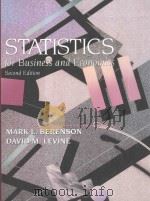
- STATISTICS FOR BUSINESS AND ECONOMICS SECOND EDITION
- 1993 PRENTICE HALL ENGLEWOOD CLIFFS
-

- STATISTICS%FOR BUSINESS AND ECONOMICS
- 1995 SOUTH-WESTERN COLLEGE PUBLISHING
-
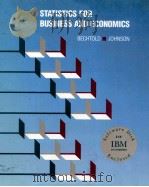
- STATISTICS FOR BUSINESS AND ECONOMICS
- 1989 PWS-KENT PUBLISHING COMPANY
提示:百度云已更名为百度网盘(百度盘),天翼云盘、微盘下载地址……暂未提供。➥ PDF文字可复制化或转WORD
